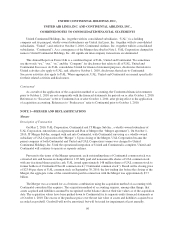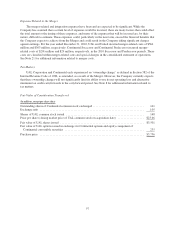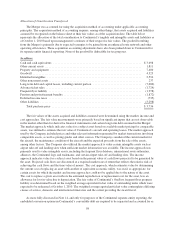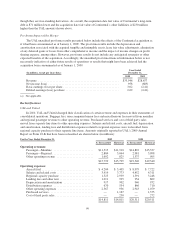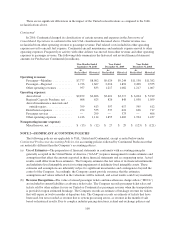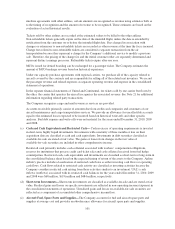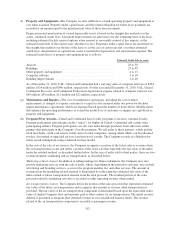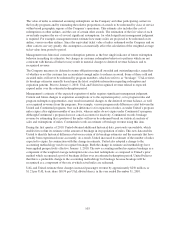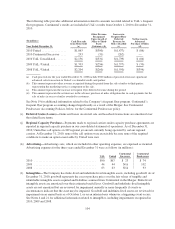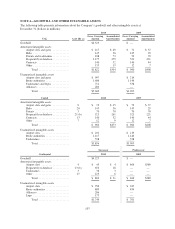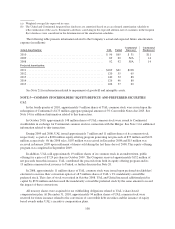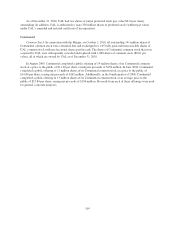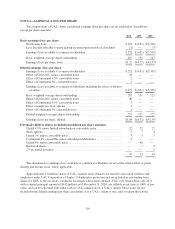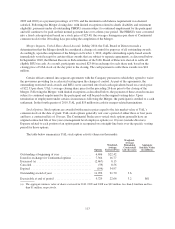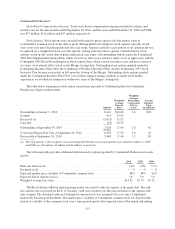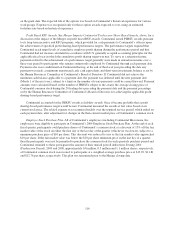United Airlines 2010 Annual Report Download - page 108
Download and view the complete annual report
Please find page 108 of the 2010 United Airlines annual report below. You can navigate through the pages in the report by either clicking on the pages listed below, or by using the keyword search tool below to find specific information within the annual report.
Property and Equipment—Property and equipment was recorded at cost and was depreciated to estimated
residual value over its estimated useful life using the straight-line method. Jet aircraft and rotable spare parts
were assumed to have residual values of 15% and 10%, respectively, of original cost; other categories of property
and equipment were assumed to have no residual value. The estimated useful lives of Continental property and
equipment were as follows:
Estimated Useful Life
Jet aircraft and simulators 25 to 30 years
Rotable spare parts
Average lease term or
useful life for related aircraft
Buildings and improvements 10 to 30 years
Vehicles and equipment 5 to 10 years
Computer software 3 to 5 years
Frequent Flyer Program Accounting—Continental accounted for mileage credits earned by flying on
Continental under an incremental cost model, rather than a deferred revenue model. For those frequent flyer
accounts that had sufficient mileage credits to claim the lowest level of free travel, Continental recorded a
liability for either the estimated incremental cost of providing travel awards that were expected to be redeemed
for travel on Continental or the contractual rate of expected redemption on alliance carriers. Incremental cost
included the cost of fuel, meals, insurance and miscellaneous supplies, less any fees charged to the passenger for
redeeming the rewards, but did not include any costs for aircraft ownership, maintenance, labor or overhead
allocation. The liability was adjusted periodically based on awards earned, awards redeemed, changes in the
incremental costs and changes in the frequent flyer program. Changes in the liability were recognized as
passenger revenue in the period of change. Continental recorded an adjustment of $27 million to increase
passenger revenue and reduce its frequent flyer liability during 2008 for the impact of redemption fees after
Continental increased such fees during 2008.
NOTE 3—RECENTLY ISSUED ACCOUNTING STANDARDS
In October 2009, the Financial Accounting Standards Board (“FASB”) issued Accounting Standards Update
No. 2009-13, Multiple Deliverable Revenue Arrangements—A Consensus of the FASB Emerging Issues Task
Force. This guidance defines whether multiple deliverables exist, how the deliverables should be separated and
how the consideration should be allocated to one or more units of accounting. This guidance establishes a selling
price hierarchy for determining the selling price of a deliverable. The selling price used for each deliverable will
be based on vendor-specific objective evidence, if available, third-party evidence if vendor-specific objective
evidence is not available, or estimated selling price if neither vendor-specific or third-party evidence is available.
The Company is required to apply this guidance prospectively for revenue arrangements entered into or
materially modified after January 1, 2011.
The Company will prospectively apply this guidance to new sales of air transportation that include a
mileage credit component beginning in the first quarter of 2011. The adoption of this standard will decrease the
value of the mileage credit component that we record as deferred revenue and increase the passenger revenue we
record at the time air transportation is provided. This change will occur because of the different assumptions we
will use to determine the estimated selling price of the mileage credit component under the new standard. The
total impact of the new accounting standard may be material and will depend on many factors, including the
volume of air transportation sales with mileage credit components.
In addition, United and Continental both have significant contracts to sell mileage credits to their
co-branded credit card partners. These contracts may be modified in 2011 as a result of the Merger. A modified
contract would be subject to the new standard in the period the contract modification is executed. We may record
material adjustments to revenue in the period we modify the contract based on the provisions of the new
standard, which requires us to adjust our deferred revenue balance as if we had been applying the new standard
since the contract initiation. The amount of any modification impact cannot be readily determined until such
contract modifications are executed.
106


